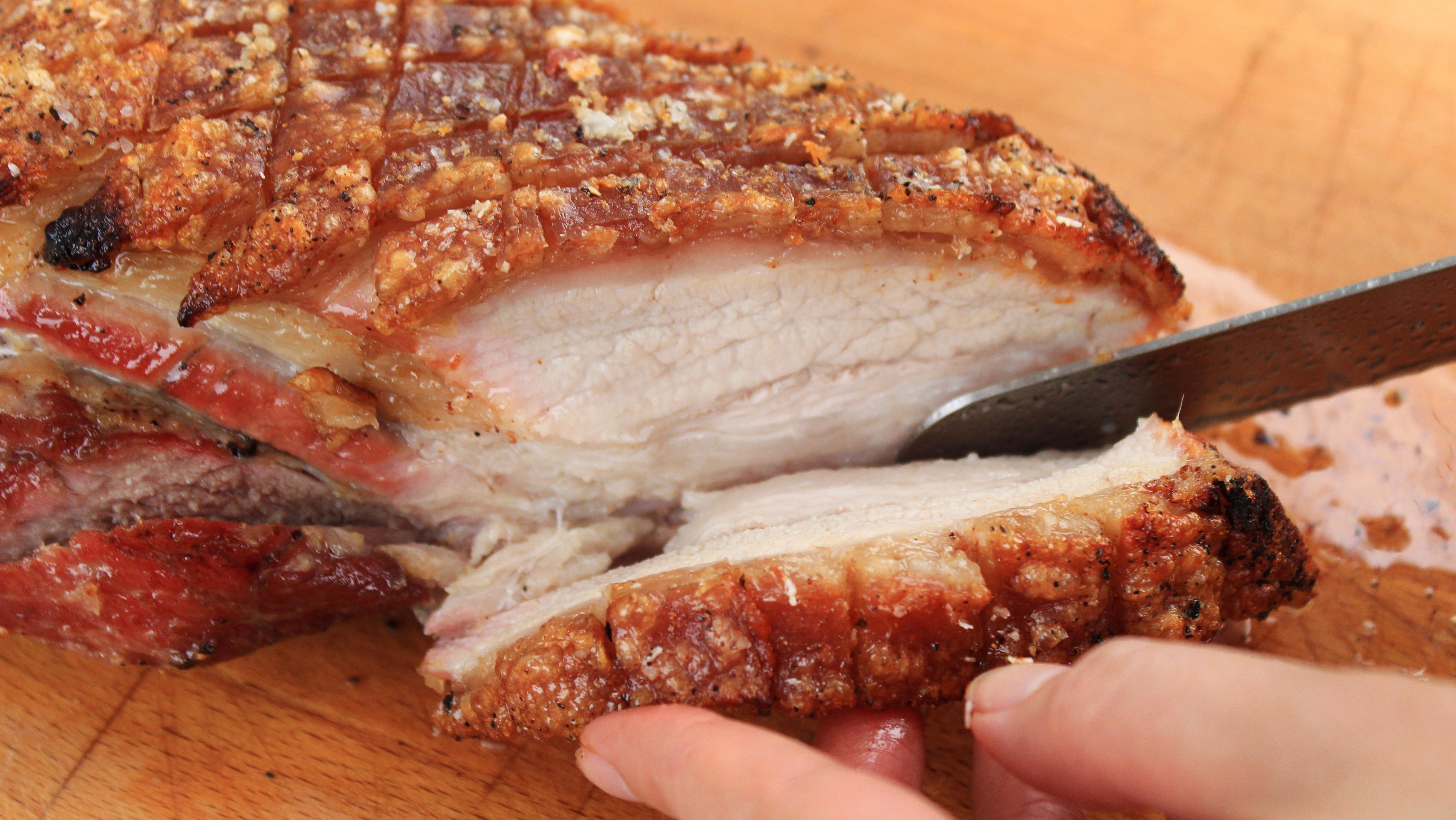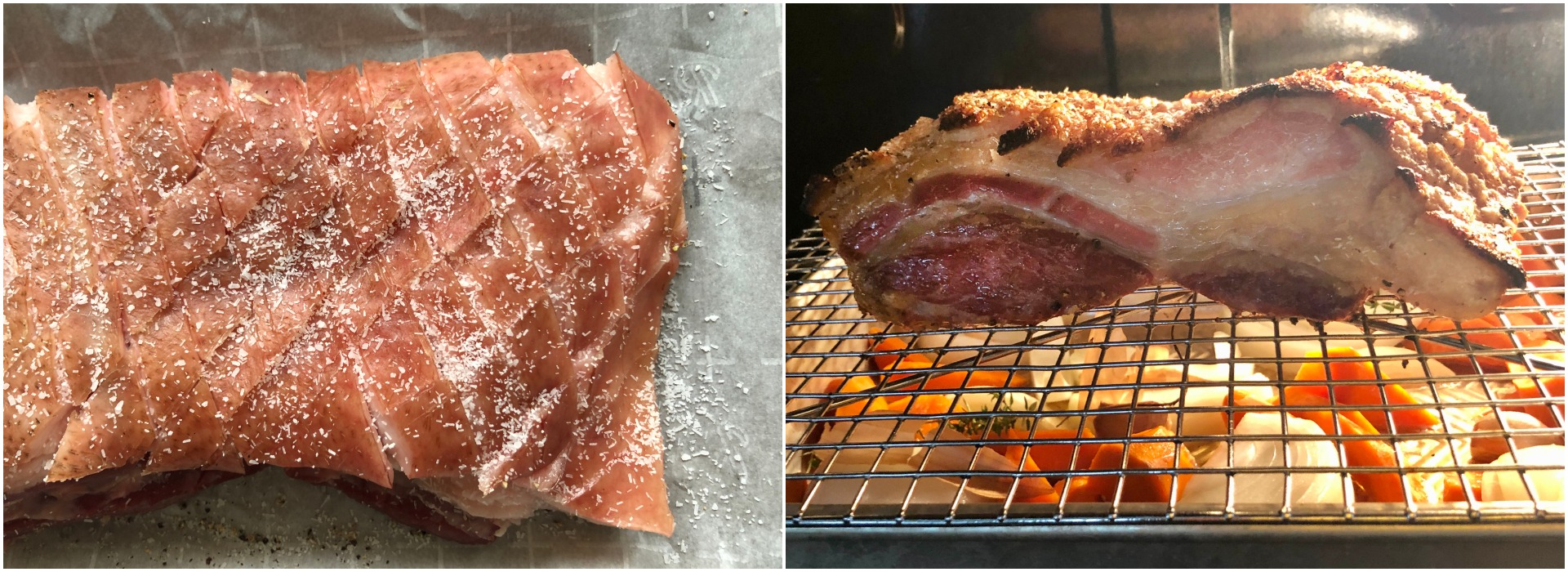How To Achieve Maximum Crackling Crunch On Your Pork Roasts
Pork with crackling. I had never had it, but often longed for it. Pork tenderloin, sure. Baked pork chops, definitely. But a roast pork with the crunchy rind attached felt... difficult. I'm a fan of British cooking shows, and pork with crackling was seemingly featured every other show—taunting me with its juicy meat, and thick coverlet of golden crunch. Next to roast beef, pork with crackling was billed as the special Sunday roast.
But why had I never crossed paths with it living in the American Midwest? We love our meat-heavy meals, served with starches and gravies aplenty. Were we afraid of pork belly if it wasn't smoked and cured? Perhaps it's the intimidating amount of fat and jiggle, too guilty a pleasure for even us?
Well, there's no looking back now. This roast is all about the fat, however, much of it is rendered out through the process of high-then-low-heat roasting. The skin and fat puff into a crunchy carapace, both shielding the meat below from the oven's heat, and basting it with juices. The result is a showstopper—in both appearance and taste. No one will ever be the same after you feed them this.
It is 100% worth the effort to find boneless, skin-on pork belly. I purchased mine from a local butcher. It was about $20 for a two-pound slab of pork, which came from a small farm about 60 miles away. It was easily enough for four people—each slice is rich and satisfying. It doesn't take much to satiate.

I had a singular goal with this project: Make a roast pork and achieve maximum crunchy crackling. The answer was in combining a number of methods I came across in my research. First, the usual impulse to salt the meat all over and leave it in the refrigerator overnight is misplaced here. While it is a good idea to let it sit uncovered in the fridge to dry out the surface, you don't want to salt the skin ahead of time. The salt will leech moisture into your fat, which will steam in the oven, thwarting your efforts to crisp it. Instead, salt it right before roasting.
Pat the pork dry and use a super sharp knife, or even a clean box cutter or utility knife, to score the skin. Make sure you cut cleanly through the skin, but keep it shallow; don't cut down through the fat and into the meat. I prefer diagonal crisscross cuts, but if you want to slice it just one way you can.
Whichever method you use to arrive to Cracklin' Town, the important thing is you do try roasting skin-on pork, be it shoulder or belly. You'll be validated as soon as you and your guests take a bite, and hear that crunch from clear across the dinner table.
To recap, you may want to use some or all of these suggestions to achieve maximum skin crunchiness:
- Don't salt the skin in advance.
- Place the pork in the freezer for about 15 minutes to firm up the slab and make it easier to score.
- Pat the skin dry before scoring it.
- Score with a very sharp knife or box cutter (change the blade first, of course).
- Consider using a meat tenderizer, the kind with needled tips, to poke tiny holes into the skin.
- Rub salt into the slits just before roasting.
- Brush on a coating of oil before placing in oven, ideally one with a high smoke point (like grapeseed or canola).
- Roast at a super high temperature for about 15-20 minutes, then at a lower heat to finish cooking.

Roast Pork Belly with Crackling
Serves 4Prep time: 10-20 minutesCooking time: 1 hour 45 minutes
- 2 to 3 lb. boneless, skin-on pork belly, ideally left to sit in the fridge overnight uncovered
- Salt
- Chopped carrots, onion, a sprig of thyme, small potatoes to roast in the drippings
Turn your oven up as high as it goes (usually 525 to 550 degrees Fahrenheit). Place the belly on a cutting board and pat dry with paper towels. Make slits through the skin as described above. Rub a little salt into each slit, and all over the meat. Brush the surface lightly canola oil.
Place the belly skin-side up on a rack with a roasting tray. When your oven reaches its highest temperature, roast the pork for about 15 minutes, checking at the 10 minute mark to make sure the skin is not burning. The skin should look golden and blistered. It should begin to sound "hard" if you scrape it with a knife. If it's not uniformly golden and hard, rotate the pan and continue to cook for 5 minutes longer.
Lower the oven temperature to 325 degrees Fahrenheit. Add vegetables to the bottom of the roasting tray. Salt, and toss with the pork drippings. Continue to roast for 1 hour 30 minutes. Don't worry about overcooking—with pork belly, it's more forgiving.
Let the pork rest for at least 10 minutes, then slice, using the diagonal cuts of the skin to guide your knife. Add fresh cracked pepper. Serve with roasted vegetables and gravy.


